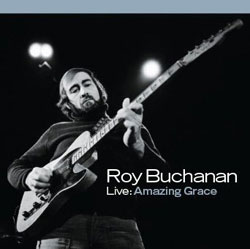We're up to #49 in Inside the Rock Era's special feature on The Top 100 Guitarists of the Rock Era*. This guy could play with the best of them. He would go off on long staccato runs that few people can do:




#49: Roy Buchanan
31 years as an active guitarist
Roy Buchanan was born September 23, 1939 in Ozark, Arkansas. Buchanan was one of the pioneers of the telecaster sound, which made use of his note-bending, volume swells, staccato runs and "pinch" harmonics. He recorded solo albums and also was a guest musician for many artists. Although he never was recognized by the masses, insiders and other guitarists recognize him as being one of the best and most influential guitarists ever.

Buchanan's first musical experiences were from racially mixed revival meetings that he would go to with his mother Minnie in Arkansas. Buchanan and his family eventually moved to Pixley, California, a farming community near Bakersfield. Roy started professionally on guitar at the age of 15 in Johnny Otis's rhythm and blues revue.
IN 1958, Buchanan recorded with Dale Hawkins for Chess Records. Two years later, Roy left Dale to play for his cousin Ronnie Hawkins and tutor Ronnie's guitarist, Robbie Robertson. Roy played bass guitar on the single "Who Do You Love?" for Ronnie, whose group later became the Band.

In the 60's, Buchanan played guitar for Freddy Cannon, Merle Kilgore, and many artists. By the end of the decade, Roy left the industry for a while to learn a trade to take care of his family, then returned a few years later in the Danny Denver Band. Buchanan played with his own group, the Snakestretchers and recorded his first album as the frontman of a group.
Buchanan gained notoriety when PBS ran a television documentary called Introducing Roy Buchanan in 1971. John Lennon and Merle Haggard are among those who praised the work and it led to a recording contract with Polydor Records. Allegedly, Roy also received an invitation to join the Rolling Stones, which he turned down.
Buchanan recorded five albums with Polydor, including Second Album, which went gold, and three with Atlantic Records, including the 1977 album Loading Zone, which also sold 500,000 copies. But Buchanan ceased to record until he could record his own music his own way. Here! Here! for doing away with "middle men".
Four years later, a small label, Alligator Records, talked Roy into recording again with full artistic freedom. He released When a Guitar Plays the Blues, Dancing on the Edge, and the twelfth and final album of his career--Hot Wires.
According to his agent and others close to him, Buchanan had gained control of his drinking habit and was doing well when he was arrested for public intoxication after a domestic dispute. On the morning of August 14, 1988, the Deputy Sheriff in Fairfax County, Virginia opened the door and found Buchanan in his jail cell, hanged from his own shirt. Buchanan's friends and family dispute the official cause of death as suicide, pointing to evidence of seeing Roy's body with bruises on the head.
After his death, several compilation and other albums continue to be released, including the previously unreleased first album for Polydor, The Prophet.

Buchanan taught himself in several techniques, including "chicken pickin'". He would use his thumb nail rather than a pick. To achieve the pinch harmonics, Buchanan would hold the pick between his thumb and forefinger, plucking the string and simultaneously touching it lightly with the lower edge of his thumb at one of the harmonic nodes. This had the effect of suppressing lower overtones and emphasising the harmonic sound. Buchanan had the ability to play harmonics at will, muting individual strings with free fingers of the right-hand while picking or pinching others. Because of his experience playing lap steel guitar, Buchanan imitated its effect on the electric guitar by bending strings to the required pitch, rather than starting on the desired note. He was famous for this.
Buchanan preferred his 1953 Fender Telecaster that he nicknamed "Nancy". Unlike today's guitarists, who need every gizmo known to man to manufacture their sound, Buchanan achieved his more on pure talent rather than special effects. He used the Fender Vibrolux with the volume and tone "full out" and then used the guitar's volume and tone controls to control the volume. In fact, Roy achieved a wah wah effect using the tone control. To achieve distortion, Buchanan used a razor blade to cut the paper cones of the speakers in the amplifier. He didn't use effects pedals widely, although he did have an Echoplex on one album and later in his career he played a DD-2 delay from Boss.

Buchanan's influence has been felt by Gary Moore, Danny Gatton and Jeff Beck, with Beck dedicating his version of "Cause We've Ended As Lovers" to Buchanan. Roy exhibited great knowledge; he could play the darkest of the blues and also play flat rock & roll. Guitar Player magazine listed Roy's "Sweet Dreams" as one of "The 50 Greatest Tones of All-Time".
Buchanan definitely deserves to rank high in any legitimate ranking of top guitar players. One only wonders what he could have achieved had he lived longer. He is #49 for the Rock Era*...
No comments:
Post a Comment
Note: Only a member of this blog may post a comment.